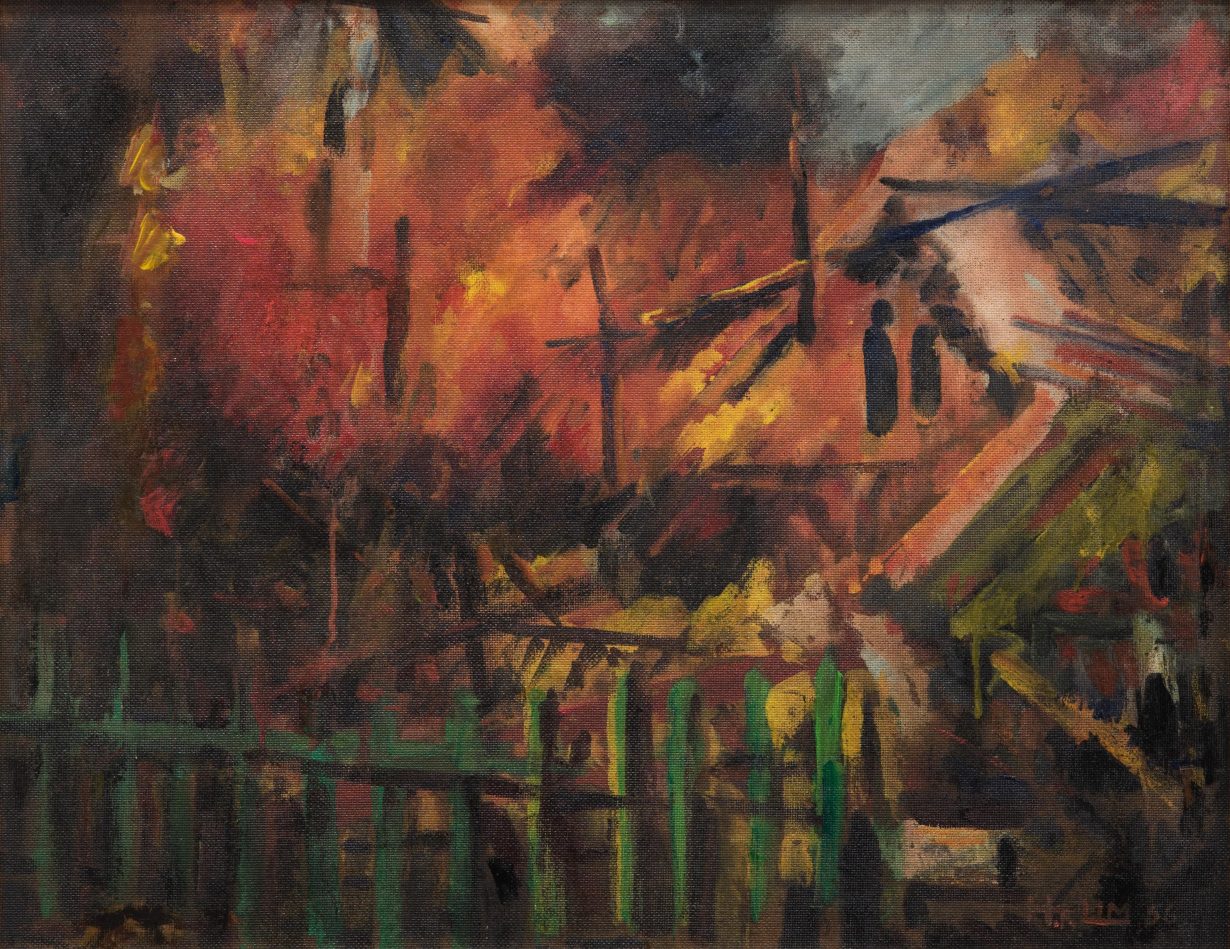Figuring a Scene uses the National Gallery Singapore collection to explore mankind’s relationship with the elements, and suggests some new ones along the way
Walls draped in crimson; a wax-laden installation with a wooden sculpture of Jesus at its centre; and an earth-brown, nut-shaped sculpture – these are the first things that catch my eye in Figuring a Scene. The exhibition, presented in National Gallery Singapore’s project space, is split into six sections, indicated by the different colourings of the gallery’s walls. Furthermore, each section is themed around an element: fire, air and other more idiosyncratic ‘elements’ like shadow, fruit, wax and the city. Comprising works from the gallery’s collection, but attempting, as the gallery claims, to ‘break free from traditional art history norms’, the works on display not only explore each element’s form, but also its relationship with and impact on mankind.
The crimson walls I first encounter belong to a gallery that refers to the Bukit Ho Swee fire, a 1961 blaze that destroyed around 16,000 homes in Singapore, as well as earlier conflagrations. In Lim Hak Tai’s acrylic painting Fire (1956), a bright red-and-orange inferno rages across the remnants of broken low-rise houses, with a compelling contrast between the undulating flames and the sharp geometrical lines of the houses. Lim Yew Kuan’s elaborate woodblock print After Fire (1966) and Choo Kuan’s pencil drawing Rebuilding Bukit Ho Swee (1962) astutely capture the aftermath of destruction. Lim’s crisp monochrome lines depict the ruined neighbourhood, with individuals grappling with nearby rubble. In contrast, Choo’s drawing resembles architectural plans with near-geometrical precision. Depicting the construction site of a high-rise building complex near roughly built wooden shelters, he foregrounds a moment of historical flux: the contrasting building styles allude to Singapore’s past and then-future urban development. Similarly, Shui Tit Sing’s two teak sculptures in the city-themed section reflect both the hopes and anxieties relating to urban development in the wake of the 1961 fire. Cooperation (Passing Metal Beams) (1976) optimistically depicts individuals working together to construct a high-rise structure, though this dream is shattered in Why (1979), where a person falls out of an apartment, with onlookers watching from their windows.

The standout section is a delightful ode to the durian – a fruit endemic to Singapore and Southeast Asia. A mix of paintings, photographs and sculptures show how this hard-shelled thorny fruit has captured artists’ imaginations. Rendered vibrantly in oil paint, Liu Kang’s Durian Vendor (1957) depicts five men seated by a body of water who are cutting, peeling and eating the iconic fruit. Two central figures tend to a pile of durians and mangosteens on a weighing scale. Nearby, a third man painstakingly removes the fruit’s flesh from its shell, while another savours it, dark brown seeds scattered around them. Nearby hangs Robert Zhao Renhui’s Durian Tree, Bukit Panjang (2024), which captures the tree in a lush forest in Bukit Panjang, Singapore. Blink and you’ll miss the striped-shirted man in the immersive composition’s lower foreground – a local forager. Rounding out the relationship between human and nature is Indonesian Anusapati’s undated Single Object. Made from the wood of a fallen durian tree, the sculpture foregrounds the material’s rich textures, grain and origin, its organic shape and ridges recalling those of a durian seed.
Lim Tzay Chuen’s photograph The Opposite is True #2 (2006) and Sun Yee’s oil painting Storm (1959) appear in the section exploring air. Sun offers a literal portrayal of bad weather: a dynamic composition of dark foliage bearing the brunt of whipping winds, as depicted by expressive streaks of white melding with a storm-blue sky. In contrast, Lim’s work documents his 2006 Singapore Biennale performance, in which he released a fog of pheromones in what was then City Hall (now the National Gallery). Eerily depicting clouds of pheromone fog in the Gallery’s unoccupied stairwells, The Opposite is True #2 foregrounds how a building’s interior can make the unseen visible.

The final sections, themed around shadow and wax, serve as compact, visceral showcases of the practices of Malaysian artist Sharon Chin and Filipino artist Renato Habulan respectively. Large dark plywood structures and printed posters depict, we are told, the night view of an oil refinery from Chin’s home in Port Dickson. Portraying Chin’s dim backyard with a refinery brightly illuminated in the distance, these posters poignantly foreground how omnipresent humankind’s mark on nature has become, even in the dark.
Habulan’s haunting Tira (Remains) (2014–23) is the exhibition’s concluding work. The artist is known for his social realist paintings, but his interests in political and colonial systems transcend the material in this sprawling installation. At its centre is an unconsecrated wooden sculpture of Jesus Christ, symbol of the Philippines’ colonial Catholicism. Paired with the violent imagery of carved, disembodied hands and driftwood in the shape of ammunition, as well as the fact that ‘tira’ means ‘to strike’ in Filipino, the installation hints at the interwoven relationship of religious colonial legacies, destruction and warfare.
It’s initially surprising to see works by celebrated names like Robert Zhao Renhui and Liu Kang in an exhibition ostensibly dedicated to lesser-known narratives. However, they offer potential entry points into the practices of artists such as Sun Yee and Anusapati – who arguably have far less of a presence in the region’s art history – by highlighting their shared interests in the area’s natural and urban phenomena. Figuring a Scene serves as insight into how artists might synthesise and represent mankind’s symbiotic relationship with what we consider natural and what we consider elemental.
Figuring a Scene at National Gallery Singapore, through 23 March 2025
